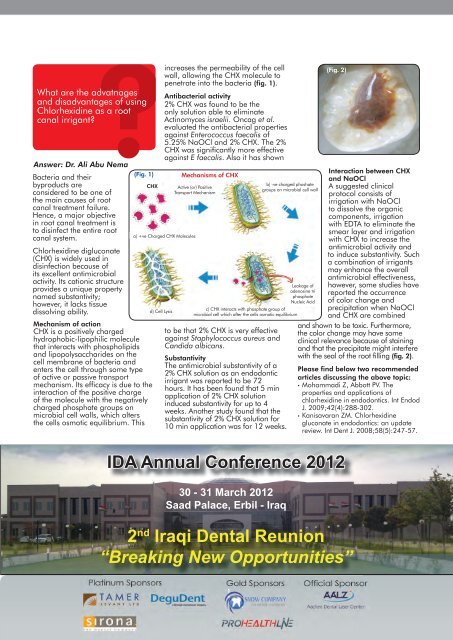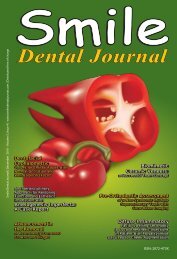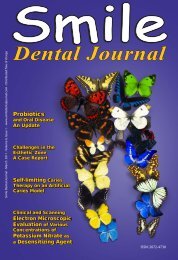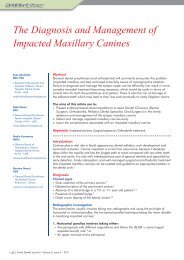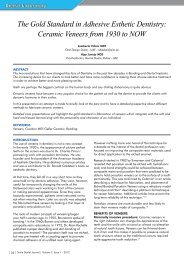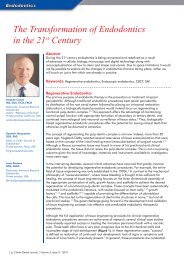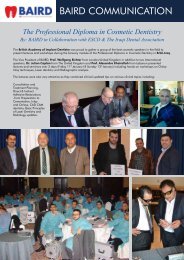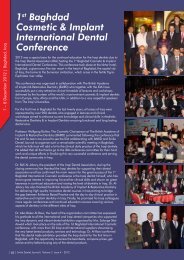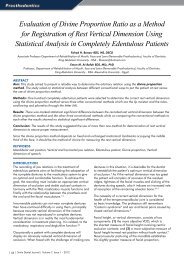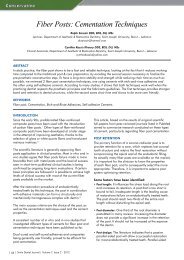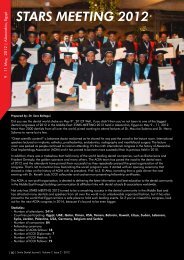Download e-copy - Smile Dental Journal
Download e-copy - Smile Dental Journal
Download e-copy - Smile Dental Journal
Create successful ePaper yourself
Turn your PDF publications into a flip-book with our unique Google optimized e-Paper software.
the beginning, with special attention to dentofacial<br />
orthopedics, will place teeth and jaws in a position that<br />
ensures the improved relationships inside TMJ and the<br />
successful completion of the subsequent prosthetic phase<br />
of the patient’s full mouth rehabilitation and greatly<br />
improve the overall esthetic result.<br />
Case 1<br />
Patient O., 40 years old presented with several concerns<br />
about her smile (figs. 1, 2): her front teeth are too<br />
vertical, gummy smile, cosmetically unpleasant prosthetic<br />
restorations (fig. 3).<br />
She also had numerous TMJ symptoms such as: “tension”<br />
headaches, headaches in right and left temple areas and<br />
back of her head. She had frequent neck aches, difficulty<br />
of opening her mouth wide, clicking sounds in her joints<br />
and ringing sounds in her ears. She was grinding her<br />
teeth at night and had pain in her TM joints.<br />
Clinical and X ray evaluations showed, that patient had<br />
Class II malocclusion, with her front maxillary teeth in<br />
vertical, almost retrusive position, trapping her mandible<br />
distally (fig. 4).<br />
Distally displaced position of the mandible pushed<br />
patient’s condyles into posterior/ superior position, thus<br />
causing abovementioned TMJ symptoms.<br />
(Figs. 1 & 2) Facial view & Natural smile of the patient O.<br />
before treatment<br />
(Fig. 3) Retracted view of the patient smile before treatment<br />
The objective of the treatment plan for this patient<br />
was to advance her mandible down and forward,<br />
thus improving her appearance and eliminating TMJ<br />
problems. Expansion of Maxilla along with protrusion<br />
of maxillary incisors forward was necessary in order to<br />
achieve required advancement of mandible.<br />
These objectives were accomplished in 4 months of<br />
treatment by using 3-Way Sagittal Removable Appliance<br />
(fig. 5).<br />
Upper and lower braces were placed in order to move teeth<br />
into best possible positions for future restorative treatment.<br />
At the end of this stage of the treatment skeletal changes<br />
in patient’s face and jaws were obvious (fig. 6).<br />
Positions of the condyles inside TMJ also changed,<br />
helping alleviate and eliminate most of her TMJ<br />
symptoms (figs. 7, 8).<br />
(Fig. 4) Cephalometric X ray before treatment<br />
Restorative part of the treatment was performed after<br />
completion of orthodontic phase. Zirconia crowns were<br />
placed on teeth #7, #10, #12, #13, #14, #19, #20,<br />
#21, #28 and #29. Porcelain veneers were place on<br />
teeth #4, #5, #6, #8, #9 and #11. (figs 9-11)<br />
The final results of the treatment may be described as<br />
a triple effect:<br />
First: Patient’s TMJ symptoms have completely disappeared,<br />
allowing her pain free and symptoms free existence.<br />
(Fig. 5) Retracted view after treatment with removable appliance<br />
<strong>Smile</strong> <strong>Dental</strong> <strong>Journal</strong> | Volume 6, Issue 4 - 2011| 27 |


